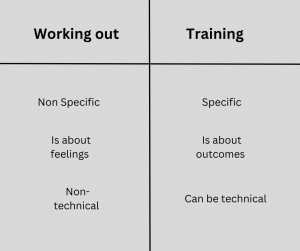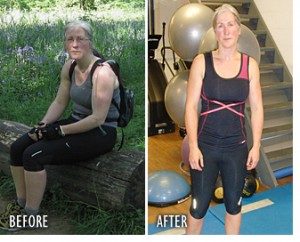Working out versus training

What is the difference between working out and training, and does it even matter?
To begin, let’s get a definition of each of these so that we understand the differences.
How do we define working out ?
Working out is exercise that doesn’t have a specific goal. If you go to Zumba, Spin, circuit training or bootcamps you are doing work outs. If you are following something on YouTube, you are probably working out. These types of exercise classes or videos don’t have you track anything like the weights that you used, or the length of your rest period between sets, or the time it took to complete the workout. You’re exercising for the sake of exercising, and there’s nothing wrong with that, it’s obviously a very good and enjoyable thing to do.
Working out is about feelings. You want to feel hot, sweaty, and tired at the end of it. You then use this as your metric as to whether an exercise class or a training program is good or bad.
How do we define training ?
Training (as the name implies) seeks to improve one or two components of physical well being. Your aerobic system, your muscle mass, or your mobility for example.
So it’s specific. You want to build muscle, you follow a training plan that is designed to do that one thing. If you want to become as fit as a Navy Seal you would not get there going to spin classes and bootcamps, you would need a training plan that has you develop your 3 main energy systems in an organised way.
Training often involves utilising technical exercises so there is often a skill component and may require coaching from an appropriately certified coach.

Which is better for fat loss? Working out or training?
Fat loss mostly comes about from showing restraint around your calorie consumption, and whilst exercise does burn calories, it doesn’t contribute that much towards your fat loss results.
However, for most people it is a necessary part of the process, so let’s figure out which is the best choice between training or working out to help with that goal.
This leads us into a conversation about motivation. If you like to do workouts and hate the monotony of training, then you obviously need to stick with doing workouts to assist your fat loss efforts, because without motivation to do them, they won’t get done.
If you prefer targeting a specific goal (like muscle hypertrophy or aerobic fitness) and get enjoyment from that, then clearly this is what motivates you to get out the door and to the gym or place where you train.
Engaging in activities that you enjoy is the key point I’m making here. Whether calorie burn is higher from working out or not is a moot point as trying to estimate how many calories you burn and consume is riddled with inaccuracy even with the most meticulous tracking apps available.
Having said all of that, there might be an argument to be made that the type of mindset you develop in training, will be more useful for a fat loss goal.
The adaptations that are the focus of training (muscle hypertrophy, strength, flexibility etc) take months to materialise. You have to trust the process, get your head down and do the work. The same can be said for fat loss, which is also a slow process.
A good rate of fat loss is between 0.5 and 2% every 2-4 weeks. To make a big change to your physique you will need to lose 5% or more. So that will take approximately 3 months and that’s if you’ve put in the required focus and dedication, and stuck to your plan.
Conversely, the work out mentality can be one of instant gratification, meaning you want to feel pushed, exhausted and like you “smashed” a workout in.
This is absolutely not the case with training, where you might have to hold yourself back to target a specific adaption, like in the case of cycling weights through hard/easy days and/or training the aerobic system.
So if I had to give the nod to one or the other, I’d give it to training just solely based upon the fact that it takes a certain type of mindset and determination to be successful in your training and that mindset can be adapted to a fat loss goal very easily.

Kat followed my Kettlebell workouts and trimmed up in just 6 weeks
How do you start working out?
First of all get clearance from your doctor. If you have some kind of medical issue, check with them first to find out if its ok to start pushing your heart rate or blood pressure up.
Assuming you’re in the clear, I would recommend going to a gym or exercise class, or hiring a personal trainer. Working out with other people is fun and you will benefit from the personal connections that you make there.
We also tend to work harder when in groups as opposed to on our own. Nothing like a bit of peer pressure to get those PR’s! There’s also the accountability factor that you don’t want to let your friend down so you motivate each other to be consistent. Which is extremely important, because you want to see results and you won’t see any unless you keep going.
With enough time working out, it will become part of your routine and part of who you are. This is the goal. To be someone who exercises consistently. This is good for your mental and physical health and you will experience these benefits if you stick with it.
How do you start training?
As above, assuming you have clearance to train from your doctor, decide what you want to achieve from your training.
Do you want elite fitness? Do you want to be able to lift heavy weight? Do you want to be able to complete the 5 minute snatch test?
First, establish a start point or baseline. Perhaps record your resting heart rate or get a Vo2 max test done at a lab.
This then enables you to put together a training plan. The plan should take into account the amount of time you have available for training each week, your overall stress level, your age, your current abilities and many other factors.
It must follow a sensible progression pattern that manipulates volume and intensity, and you must be able to recover from the training.
Some of this will take trial and error to learn, even with the help of a coach, although a coach will be able to help you navigate these waters more successfully and avoid the many pitfalls that could slow you down or get you injured otherwise.
Conclusion
So there we go! I’ve given you the differences, and now it’s up to you to figure out which you prefer, training or working out?
However, there’s no reason why you can’t do both, for instance you could follow a 6 week plan to improve your press up strength. The training plan for this goal might only have a time investment of 3 x 20 min sessions each week, this could easily be dropped into or around your regular workouts.
Hopefully this article has helped you think about what you want from your time spent working on your physical and mental well being.
If you have any questions about anything discussed in this article, you can leave a comment below and I will get back to you ASAP.
Thanks for reading and keep an eye out for more articles like this coming out soon.
Pete
Owner/Head coach BKC
